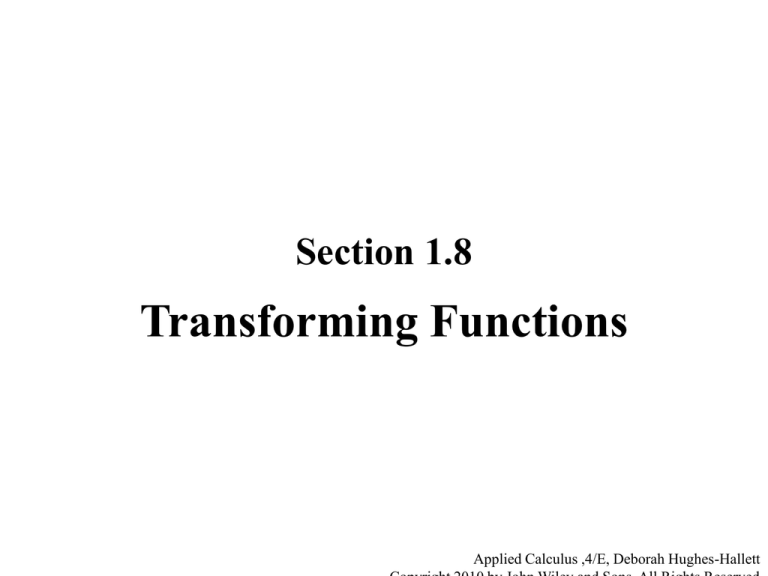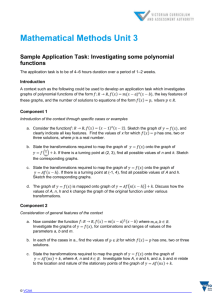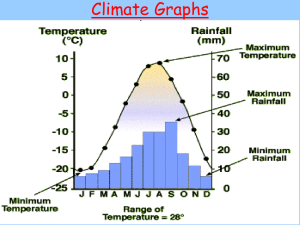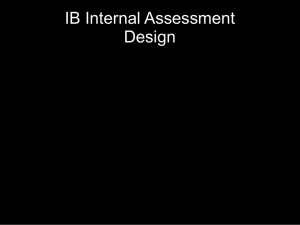ConcepTest * Chapter 1
advertisement

Section 1.8 Transforming Functions Applied Calculus ,4/E, Deborah Hughes-Hallett The graphs in Figure 1.11 (I)–(IV) are that of y = f(x). Which could be a graph of cf(x)? Figure 1.11 The graphs in Figure 1.11 (I)–(IV) are that of y = f(x). Which could be a graph of f(x) − k? Figure 1.11 The graphs in Figure 1.11 (I)–(IV) are that of y = f(x). Which could be a graph of f(x − h)? Figure 1.11 Let f and g have values given in the table. x −2 −1 0 1 2 f(x) g(x) 1 −1 0 1 −2 2 2 0 −1 −2 4. f(g(1)) = -2 5. f(g(0)) = -1 6. f(g(-1)) = 2 7. If f(g(x)) = 1, then x = 2 8. If f(g(x)) = 0, then x = -2 9. If g(f(x)) = 2, then x = -1 10. If g(f(x)) = -2, then x = 1 Let the graphs of f and g be as shown. Estimate the values. g(f(0)) ≈ 1 g(f(8)) ≈ 5 g(f(3)) ≈ 2 f(g(2)) ≈ 1 f(g(-1)) ≈ 0 Given the graphs of the functions g and f in Figures 1.13 and 1.14, which of the following is a graph of f(g(x))? g(x) f(x) Given the graph of 𝑓(𝑥), sketch the graphs of a. 2 + 𝑓(𝑥) c. 𝑓( 𝑥 + 1) b. 2𝑓 𝑥 d. 1/𝑓(𝑥) 6 4 2 6 4 2 2 2 4 6 4 6 One of the graphs below shows the rate of flow, R, of blood from the heart in a man who bicycles for twenty minutes, starting at t = 0 minutes. The other graph shows the pressure, p, in the artery leading to a man’s lungs as a function of the rate of flow of blood from the heart. • Estimate 𝑝(𝑅 10 ) and 𝑝(𝑅 22 ). • 𝑝(𝑅 10 ) ≈ 𝑝(18) ≈ 23 • 𝑝(𝑅 22 ) ≈ 𝑝(10) ≈ 17 • Explain what 𝑝(𝑅 10 ) means in practical terms. • After 10 minutes of bicycling, the pressure in the artery leading to the man’s lungs is about 17 mm Hg. x2 18. If f ( x) x 1 and g( x) e , then what are f ( g( x)) and g( f ( x))? 2 𝑓(𝑔(𝑥)) = 2 2𝑥 𝑒 = 𝑔 𝑓 𝑥 +1 =𝑒 2 2 𝑥 𝑒 𝑥 2 +1 2 +1 =𝑒 𝑥 2 +1 The graph in Figure 1.15 could be that of 1 (a) y ln x 2 1 (b) y ln x 2 1 (c) y ln( x ) 2 1 (d) y ln( x ) 2 Figure 1.15 19. Sketch graphs of the following functions. (a) y = −ln(4 + x) (b) y = ln(4 − x) (c) y = 3x−4 (d) y = 34−x











